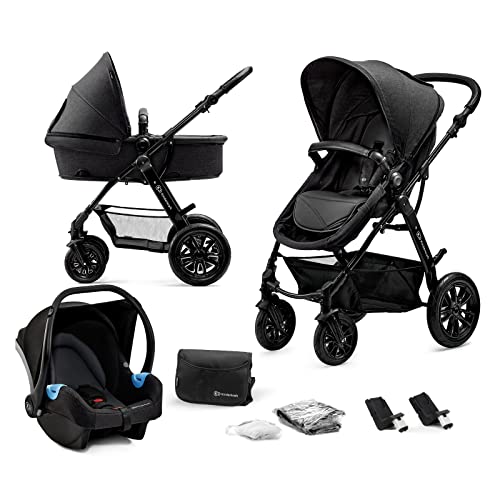Understanding Baby Prams and Pushchairs: A Comprehensive Guide
When it concerns looking after a newborn or a baby, few products are as vital as a trustworthy baby pram or pushchair. These movement aids provide a safe, comfortable way to transfer babies while enabling parents and caregivers the freedom to browse the world. This post explores the various elements of baby prams and pushchairs, assisting moms and dads make notified decisions about which item may be best matched for their household's requirements.
What Are Baby Prams and Pushchairs?
Baby Prams: These are usually designed for infants and extremely young babies. They have completely reclining seats that enable for a flat position, making them ideal for newborns. Prams frequently feature a big, deep body, providing additional defense and convenience.
Pushchairs: Pushchairs, also called strollers, are more versatile and can normally be adjusted for toddlers too. They are lightweight, simple to navigate, and frequently feature a range of seating positions, consisting of reclined and upright.
| Function | Baby Prams | Pushchairs |
|---|---|---|
| Ideal Age | Newborn to around 6 months | Newborn to 3 years or more |
| Seat Position | Totally reclined | Adjustable (reclined and upright) |
| Weight | Heavier, more robust | Lighter, more compact |
| Folding Mechanism | More intricate folding | Typically easier folding |
| Maneuverability | Can be less maneuverable | Extremely maneuverable |
Key Features to Consider
When picking a baby pram or pushchair, potential buyers need to consider several essential functions that can influence the usability and convenience for both the child and the caretaker.
1. Safety Features
- Five-point Harness: Ensures the baby is securely strapped in.
- Brakes: Reliable braking systems avoid accidents.
- Stability: A broad base and sound frame improve stability.
2. Convenience
- Cushioning: Ample padding on the seat ensures comfort.
- Suspension System: Provides a smoother trip on irregular surfaces.
- Canopy: A big, adjustable canopy secures the baby from sun and rain.
3. Portability
- Weight: Lighter models are much easier to raise and bring.
- Folding Mechanism: Easy folding designs permit fast storage and transport.
- Compact Size: A more compact size makes it simpler to suit vehicle boots and tight spaces.
4. Flexibility
- Convertible Options: Some designs can be adjusted from a pram to a pushchair.
- Reversible Seat: Allows the baby to face the parent or the world, depending upon choice.
- Devices: Look for alternatives that can accommodate safety seat or have a storage basket.
5. Sturdiness
- Product Quality: Invest in higher-end materials for longevity.
- Weather Resistance: Water-resistant fabrics guarantee that the pram/pushchair can withstand different weather condition conditions.
Types of Baby Prams and Pushchairs
Several kinds of baby prams and pushchairs fulfill various function requirements, aligning with moms and dads' particular lifestyles.
1. Travel Systems
Travel systems usually combine a car seat and a stroller in one bundle, permitting smooth transport from automobile to pram or pushchair without interrupting the baby.
2. Umbrella Strollers
Umbrella strollers are lightweight and convenient, created for simpler maneuverability. They are perfect for fast trips and might lack some functions discovered in full-size strollers.
3. All-Terrain Pushchairs
These are ideal for active families who delight in treking or taking walks on rugged terrains. They typically come with larger wheels for stability.
4. Jogging Strollers
Jogging strollers are created for moms and dads who want to combine workout with child care. They feature strong frames and repaired front wheels to boost security during a run.
The Importance of Choosing the Right Option
Picking the suitable baby pram or pushchair is not simply a matter of choice; it straight impacts the security and comfort of the baby. Furthermore, pushchairsandprams can exceptionally influence the way of life of the caretakers.
Advantages:
- Convenience: A well-chosen pram or pushchair makes outings much easier and more satisfying.
- Health: Proper assistance helps in back and skeletal development in babies.
- Bonding: Outdoors play a vital role in parent-child bonding.
Often Asked Questions (FAQs)
1. At what age can my baby utilize a pushchair?
Most pushchairs are created to accommodate babies as young as six months, although some models can be changed to securely carry newborns when used with suitable safety seat.
2. How do I keep my baby pram or pushchair?
Regular cleansing is important. Wipe down the frame and material with a moist fabric and mild soap. Periodically inspect the wheels and brakes for wear and tear.
3. Can I use a baby pram for jogging?
Normally, no. Routine baby prams do not have the stability and style needed for running. It is much safer to utilize a stroller specifically developed for that purpose.
4. How do I choose the ideal size?
Consider how often you will be using the pram/pushchair and where. If space is restricted, look for a more compact style. For outdoor adventures, select one with larger wheels and good suspension.
Baby prams and pushchairs are indispensable tools for moms and dads and caretakers, enabling safe and comfortable transportation of babies and young children. By understanding the numerous features, types, and advantages included, caretakers can select the very best movement aid suited to their requirements. Whether it be an advanced travel system or a simple umbrella stroller, the right purchase can significantly enhance the experience of being a parent, making getaways enjoyable and trouble-free for both parents and babies alike.

